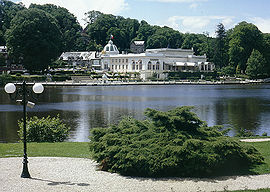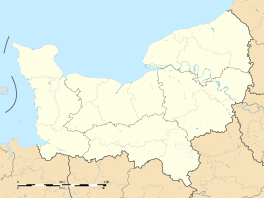Bagnoles-de-l'Orne
| Bagnoles-de-l'Orne | |
|---|---|

Lake and casino
|
|
| Coordinates: 48°32′59″N 0°25′25″W / 48.5497°N 0.4236°WCoordinates: 48°32′59″N 0°25′25″W / 48.5497°N 0.4236°W | |
| Country | France |
| Region | Normandy |
| Department | Orne |
| Arrondissement | Alençon |
| Canton | Bagnoles-de-l'Orne |
| Government | |
| • Mayor (2011–2014) | Jean Pierre Blouet |
| Area1 | 9.26 km2 (3.58 sq mi) |
| Population (2008)2 | 2,502 |
| • Density | 270/km2 (700/sq mi) |
| Time zone | CET (UTC+1) |
| • Summer (DST) | CEST (UTC+2) |
| INSEE/Postal code | 61483 /61140 |
|
1 French Land Register data, which excludes lakes, ponds, glaciers > 1 km² (0.386 sq mi or 247 acres) and river estuaries. 2Population without double counting: residents of multiple communes (e.g., students and military personnel) only counted once. |
|
1 French Land Register data, which excludes lakes, ponds, glaciers > 1 km² (0.386 sq mi or 247 acres) and river estuaries.
Bagnoles-de-l'Orne is a former commune in the Orne department in northwestern France.
On 1 January 2000, Tessé-la-Madeleine and Bagnoles-de-l'Orne merged becoming one town called Bagnoles-de-l'Orne, however, it adopted the former Insee code of Tessé-la-Madeleine (61483) for identification purposes. On 1 January 2016, it was merged into the new commune of Bagnoles-de-l'Orne-Normandie.
This commune is famous for its hydrotherapic baths, which are known for their supposed healing powers for rheumatic, gynaecologic and circulatory problems. The origins of thermal activity are said to date back to the Middle Ages. The spa is centred on the lake, which is formed by the River Vée, a tributary of the Mayenne, before it enters a deep gorge cut through the massif of the Andaines Forest.
Local legend tells of the medieval lord, Seigneur Hugues de Tessé. Believing that his once-glorious horse, "Rapide", was reaching the end of its life, Seigneur Hugues decided to abandon it in the Andaines Forest. He was amazed when the animal returned home some time later, strong and totally revitalized. Without resentment, "Rapide" took its master along to the waters of Bagnoles where he drank and was also rejuvenated. The spa was born.
According to another tale, a very old Franciscan monk who took the waters in Bagnoles found a new astonishing vigour and leapt across the highest rocks above the town, which are still called "Le Saut du Capucin" (The Monk's Leap).
Another facet of this fascinating place is the Arthurian legend, since Bagnoles and its surroundings are supposed to be Lancelot's country. The village's calendar of cultural events includes a visit of the most famous Arthurian sites.
The "Belle Époque" Quarter in Bagnoles-de-l'Orne constitutes a rather well preserved example of what could be classed as a typical early 20th century French bourgeoise residential area. Built between 1886 and 1914 and located in the southern part of the town, it is filled with superb villas with polychrome façades, bow windows and unique roofing. Similar projects were developed throughout France at the same time, among which are Le Vésinet close to Paris, the Saurupt Park in Nancy and the "Winter Town" of Arcachon.
...
Wikipedia


